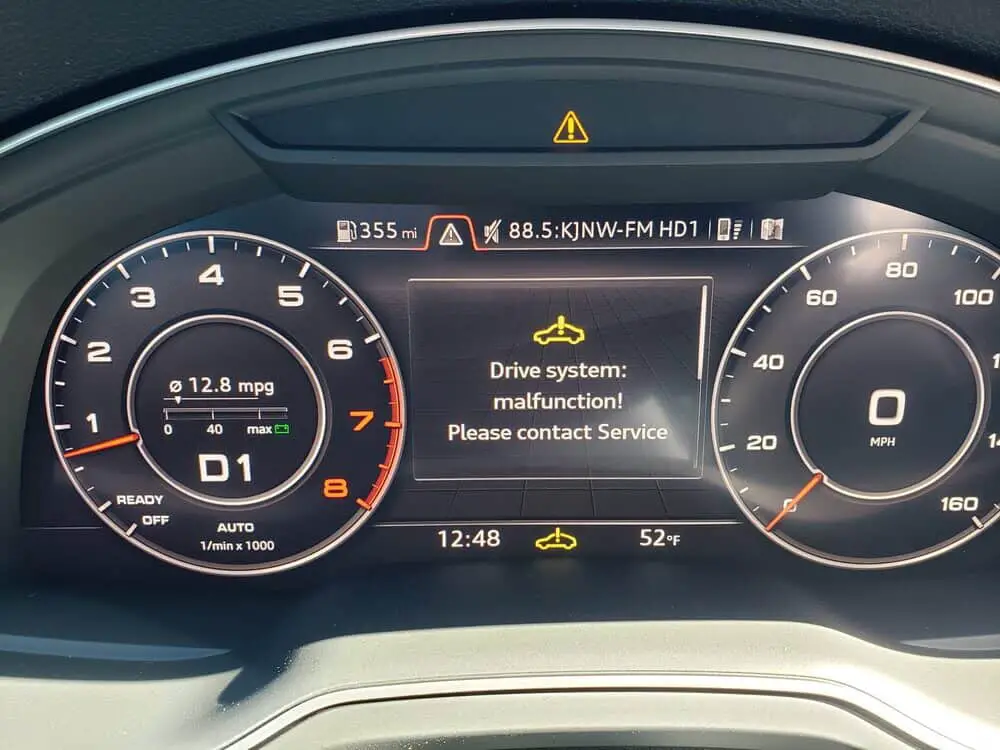Did you experience a driving system malfunction in an Audi?
Audi vehicles are known for their advanced technology and luxurious features. Audi Drive Select is an innovative feature that allows the driver to customize various vehicle settings. Such settings may include steering feel, throttle response, suspension stiffness, and transmission behavior.
Drivers are allowed to customize these settings to make the car more comfortable.
However, like any system, the Audi Drive Select system is susceptible to malfunctions. And when it occurs, a message on the dashboard indicates, “Drive System Malfunction.”
This warning restricts the driver from customizing the settings and poses a significant safety concern that requires attention. In the post below, we will explore the possible causes and symptoms of Audi’s drive system malfunction and discuss potential remedies for the issue.
Drive System Malfunction Audi Car

- A faulty control module for the drive system
The Audi drive system consists of a control module and several motors that propel the various components in the system. A faulty control module can cause one of the actuators in the air suspension system to malfunction.
When the suspension system fails to adapt to different driving situations, the Drive Select system detects the fault. It then disables itself, which leads to error messages on the dashboard. [1].
Solution: To address this issue, the control module can be reset by cycling the ignition or driving at highway speeds for several miles. If resetting doesn’t resolve the problem, the control module might need replacement with a new one.
- Engine Misfires
An engine misfire occurs when one or more cylinders fail to ignite during combustion. When this happens, the engine’s performance is adversely affected.
This results in rough idling, poor acceleration, and potentially triggering a malfunction in the Audi Drive Select system [2].
Solution: Diagnosing the root cause of an engine misfiring is crucial to resolve the issue effectively. Audi vehicles have advanced diagnostic systems that allow technicians to retrieve error codes and identify misfired cylinders using a scan tool.
The technician will identify common causes of engine misfires based on the diagnostic scan. Common culprits include worn spark plugs and ignition coils, clogged fuel injectors, and catalytic converter malfunctions.
Engine misfiring is also linked to timing chain problems.
You will hear rattling noises when starting the engine and see dirty engine exhaust if there are problems with the timing chain.
The problem causes either lean or rich fuel mixtures, leading to misfires.
Solution: Regular maintenance and replacement of faulty engine components will prevent engine misfires and ensure smooth operation.
- Faulty Steering Angle Sensor
The Audi adopts the steering angle sensor for customizing settings based on individual driver preferences. If this sensor malfunctions, the system may not accurately read the driving preferences. This leads to errors in the system.
The malfunction occurs for several reasons, including corrosion, electrical, or sensor calibration problems. One common symptom of a faulty steering angle sensor is the inability to switch between driving modes.
This causes dashboard error messages and affects vehicle handling and responsiveness [3].
Solution: Sometimes, the system can intermittently reset itself which might temporarily fix the problem. If that doesn’t work, you may need to remove, clean, and reinstall the sensor. In extreme cases, the damaged sensor may need to be replaced.
- Faulty Cables or Connectors
Audi Drive Select relies on numerous cables and connectors that connect to various vehicle parts, including the steering wheel and seat controls. With time, those cables might become disconnected, loose, or damaged due to ordinary wear and tear.
One common issue with faulty connectors is poor contact, often resulting in intermittent problems [4].
When this happens, the control module might not receive the correct signals from the affected components. This causes error messages or difficulty adjusting the desired settings.
Solution: A good contact spray can solve the problem if the issue is due to poor contact.
However, contact spraying may not be effective in severe cases with physically damaged connectors, leading to persistent trouble. Hence, replacing the affected parts with genuine Audi components is advisable.
- Low Battery Voltage
Low battery voltage can trigger the Audi Drive System Malfunction warning. Even if the battery is good, the charging system might not be providing enough power for a standard charge.
This occurs if the vehicle is not driven regularly and causes the vehicle’s computer to constantly drain power from the battery. Low battery voltage can also result from insufficient charging, parasitic battery drain, damage, or old age [5].
Vehicle electrical systems rely heavily on batteries to power various components and sensors. When the battery voltage drops below a certain point, it can trigger a malfunction in the drive and other electronic systems. Such will disrupt normal functioning.
Solution: Check the battery voltage with a voltmeter at idle and while revving the engine. If the voltage drops below the recommended level, the alternator or voltage regulator may need to be inspected or replaced.
Read Also: Are Walmart Car Batteries Good
- Closing or Opening the Trunk Lid
Closing or opening an Audi vehicle’s trunk lid may seem innocuous, but it can surprisingly lead to drive system malfunctions. The trunk lid switch checks if the trunk is closed correctly, and can cause a false signal to the vehicle’s onboard computer. [7]
The signal will then trigger a fault code or display an error message indicating “Audi Drive System Malfunction.”
Solution: To troubleshoot, reset the vehicle’s systems after any trunk movement. If the issue persists, consult an experienced Audi mechanic or an authorized service center for a proper diagnosis.
The mechanic will use specialized diagnostic equipment to scan the vehicle’s onboard computer for error codes and retrieve valuable information about the malfunction.
After diagnosis, the mechanic will perform necessary repairs, such as mending or replacing the trunk lid switch, addressing wiring issues, or reprogramming the onboard computer if needed.
- Faulty Tire Pressure Monitoring System (TPMS)
Incorrect tire pressure can trigger the Audi Drive System Malfunction warning. The TPMS is responsible for tire pressure and temperature monitoring.
Any tire with low air pressure or a failed Auto Braking System brake sensor will activate an alert and turn off the Audi Drive Select system until the issue is resolved.
Ensure proper tire pressure and fix any leaks.
Additionally, performing a simple reset on the car’s computer might help. If the TPMS sensor is corroded, a new sensor may be necessary.
Symptoms of Drive System Malfunction Audi
![]()
- Warning Lights
The most apparent indication of a driving system malfunction in an Audi is the illumination of warning lights on the dashboard. These lights act as a clear signal that the onboard computer has detected a problem with the vehicle’s system and needs attention.
Some warning lights may include engine monitoring lights, transmission warning lights, ABS (Anti-lock Braking System) lights, or other system-specific indicators. Each of these lights represents a different part of the drive system that needs to be examined and repaired. [8]
- Unusual Noises and Vibrations
Another common symptom of a driving system malfunction in an Audi is the occurrence of strange noises from under the vehicle. Whining or grinding sounds can indicate transmission issues, while clunking noises signal trouble with the differential, drive shafts, or axles.
You might also experience abnormal vibrations or shuddering while driving. These vibrations may become more noticeable at certain speeds or during acceleration, suggesting issues with the driveshaft, axles, or differential.
- Sluggish Accelaration
If you notice that your Audi has decreased or no power during acceleration, it could be a sign of transmission or clutch problems. Slipping gears or delayed gear engagement are common symptoms of drive system malfunctions.
This issue affects vehicle performance and can pose a safety hazard, especially when merging onto highways or overtaking.
Read Also: What Is Dumping The Clutch
- Gear Shifting Difficulties
The transmission in an Audi, whether manual or automatic, should shift gears smoothly. It is a telltale sign of transmission trouble if you encounter difficulty shifting gears.
Any hesitations, jerking, or inability to engage gears properly should prompt a thorough inspection by a technician. [9]
- Reduced Fuel Efficiency
A dysfunctional drive system can also lead to poor fuel economy as the engine struggles to deliver power to the wheels. Reduced efficiency can result from various issues within the drive system, such as transmission problems or excessive axle drag.
For that reason, monitoring your vehicle’s fuel economy and noting any significant drops in mileage can help detect potential drive system issues early enough.
Related: Audi Parking Brake Malfunction
Conclusion
Experiencing the Audi Drive System Malfunction warning can be frustrating and potentially dangerous. It is, therefore, necessary to take the car to a mechanic for diagnosis to determine the underlying source of the failure.
Moreover, identifying the symptoms and promptly addressing the issues is key to preventing further damage to your vehicle.
Regular maintenance, software updates, and adherence to Audi’s service schedule are essential to preventing drive system malfunctions. This will guarantee optimal performance and reliability.
Read Also: BCI Malfunction Nissan Armada





